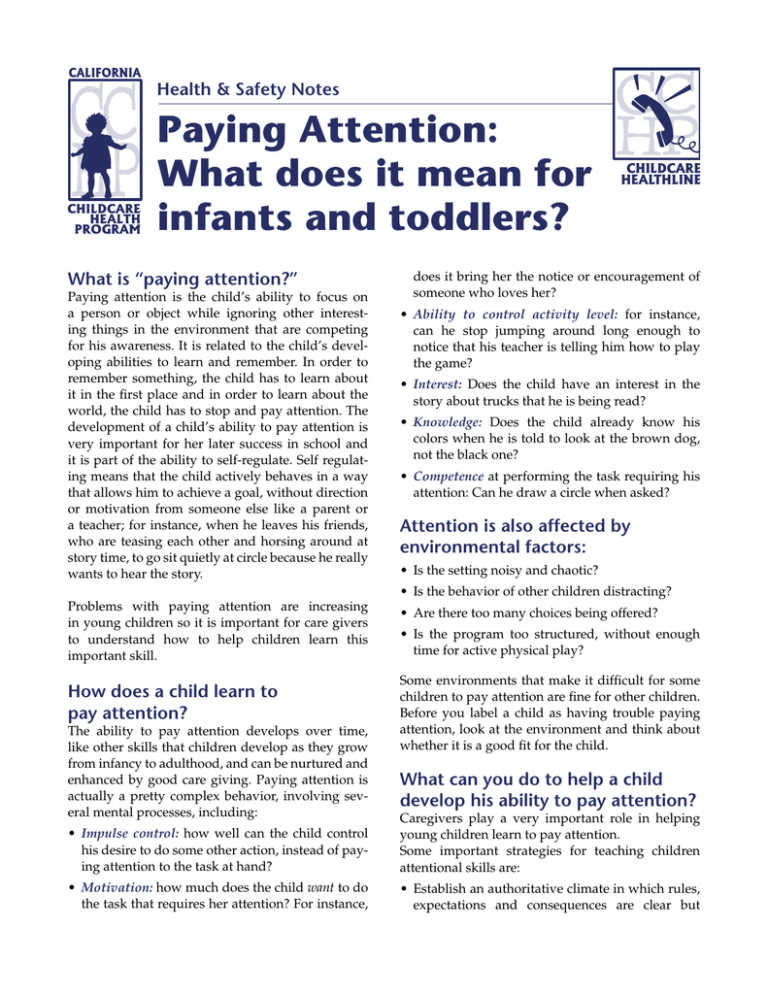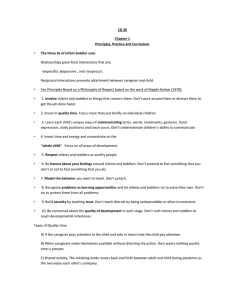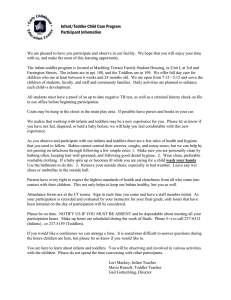Paying Attention: What does it mean for infants and toddlers? (PDF
advertisement

Health & Safety Notes Paying Attention: What does it mean for infants and toddlers? What is “paying attention?” Paying attention is the child’s ability to focus on a person or object while ignoring other interesting things in the environment that are competing for his awareness. It is related to the child’s developing abilities to learn and remember. In order to remember something, the child has to learn about it in the first place and in order to learn about the world, the child has to stop and pay attention. The development of a child’s ability to pay attention is very important for her later success in school and it is part of the ability to self-regulate. Self regulating means that the child actively behaves in a way that allows him to achieve a goal, without direction or motivation from someone else like a parent or a teacher; for instance, when he leaves his friends, who are teasing each other and horsing around at story time, to go sit quietly at circle because he really wants to hear the story. Problems with paying attention are increasing in young children so it is important for care givers to understand how to help children learn this important skill. How does a child learn to pay attention? The ability to pay attention develops over time, like other skills that children develop as they grow from infancy to adulthood, and can be nurtured and enhanced by good care giving. Paying attention is actually a pretty complex behavior, involving several mental processes, including: does it bring her the notice or encouragement of someone who loves her? • Ability to control activity level: for instance, can he stop jumping around long enough to notice that his teacher is telling him how to play the game? • Interest: Does the child have an interest in the story about trucks that he is being read? • Knowledge: Does the child already know his colors when he is told to look at the brown dog, not the black one? • Competence at performing the task requiring his attention: Can he draw a circle when asked? Attention is also affected by environmental factors: • Is the setting noisy and chaotic? • Is the behavior of other children distracting? • Are there too many choices being offered? • Is the program too structured, without enough time for active physical play? Some environments that make it difficult for some children to pay attention are fine for other children. Before you label a child as having trouble paying attention, look at the environment and think about whether it is a good fit for the child. What can you do to help a child develop his ability to pay attention? • Impulse control: how well can the child control his desire to do some other action, instead of paying attention to the task at hand? Caregivers play a very important role in helping young children learn to pay attention. Some important strategies for teaching children attentional skills are: • Motivation: how much does the child want to do the task that requires her attention? For instance, • Establish an authoritative climate in which rules, expectations and consequences are clear but caregivers are loving, patient, attentive and listen to children’s opinions. • Help children to focus by directing their attention and then encouraging a conversation that extends the child’s interest in the activity. • Make direct eye contact to assure you have the child’s attention before starting an activity. • Encourage children to learn to use words to plan their behavior, for instance, “what do we need to put on before we go out to play when it’s raining?” • Show children how to solve problems systematically; for instance, helping a child to articulate the rules of a fantasy game, so that everyone understands how to play together. • Admire a child’s effort when she successfully completes a demanding task. • A distracted child may be helped by putting your arm around him or sitting close by. • Prepare children verbally for a change in activity. • Help children to understand what their peers are feeling by stating feelings in words, i.e. “Jack is feeling sad because his mother just left. He will be ready to play with you in a few minutes.” It is also important to look at whether your expectations of the child are realistic for his age and development: The child’s temperament will also affect her ability to pay attention. Some children are naturally observant, easy-going, and easily settled. It is easier for them to attend to the world. The active, spirited infant or toddler needs more patience and help to settle and pay attention. A shy, reserved toddler needs coaxing and a patient caregiver who will introduce the world at the child’s pace. Research has shown that attention difficulties may also be inherited. Children who have family members who are easily distracted may need particular help learning to pay attention. How caregivers interact with infants and toddlers will directly affect their ability to learn to pay attention for longer and longer periods. Helping infants and toddlers to learn to pay attention to their world is an investment that will pay back many times over as the child grows into a competent, interested and engaged student in elementary school. Resources and References: Family Front and Centre: Book 2: Attention. Jewish Family Services of the Baron de Hirsch Institute. www. familyfrontandcentre.com/eng/index.html. Parrinello R., Ruff H. 1988. The influence of adult intervention on infants’ level of attention. Child Development, 59, 1125-35. Ruff, H. & Capozzoli, M.2003 Development of Attention and Distractibility in the First 4 Years of Life. Developmental Psychology. 39:877-890. • Infants pay attention by turning to sounds or by looking at things. Younger infants look longer than older infants because it takes them longer to “encode” the object mentally. Infants also pay more attention to sounds than to things they see, so if you show an infant a toy and someone makes an unusual noise, he will turn his attention from the toy to the noise. For this reason, pay attention to the level of background noise in the child’s environment. • Two-year-olds can only devote their attention to one thing for about two minutes when they have the help of an adult and for a minute or less when they are on their own. Then they need to take a break or do something else. They may also have difficulty paying attention to instructions. Asking toddlers for more attention than this is not good for them or for you as a caregiver because everyone will be disappointed. California Childcare Health Program • 1950 Addison Street, Suite 107 • Berkeley, CA 94704-1182 510–204-0930 • Fax 510–204-0931 • Healthline 1-800-333-3212 • www.ucsfchildcarehealth.org Telephone 09/07


